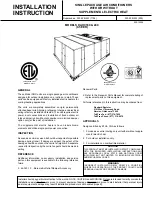
En-6
4.3.3. Pipe connection
CAUTION
Be sure to install the pipe against the port on the indoor unit and the outdoor unit
correctly. If the centering is improper, the
fl
are nut cannot tightened smoothly. If the
fl
are nut is forced to turn, the threads will be damaged.
Do not remove the flare nut from the indoor unit pipe until immediately before
connecting the connection pipe.
Do not use mineral oil on
fl
ared part. Prevent mineral oil from getting into the system
as this would reduce the lifetime of the units.
Hold the torque wrench at its grip, keeping it at a right angle with the pipe, in order to
tighten the
fl
are nut correctly.
(1) Detach the caps and plugs from the pipes.
(2) Center the pipe against the port on the indoor unit, and then turn the
fl
are nut by
hand.
Connection pipe (Gas)
Connection pipe
(Liquid)
(3) When the
fl
are nut is tightened properly by your hand, hold the body side coupling
with a separate spanner, then tighten with a torque wrench. (See the table below for
the
fl
are nut tightening torques.)
Tighten with 2 wrenches.
Holding wrench
Flare nut
Connection pipe
Indoor unit pipe
(Body side)
Torque wrench
Flare nut [in. (mm)]
Tightening torque [lbf·ft. (N·m)]
1/4 (6.35) dia.
11.8 to 13.3 (16 to 18)
3/8 (9.52) dia.
23.6 to 31.0 (32 to 42)
1/2 (12.70) dia.
36.1 to 45.0 (49 to 61)
5/8 (15.88) dia.
46.5 to 55.3 (63 to 75)
3/4 (19.05) dia.
66.4 to 81.1 (90 to 110)
4.4. Installing heat insulation
CAUTION
After checking for gas leaks (refer to the Installation Manual of the outdoor unit),
perform this section.
Install heat insulation around both the large (gas) and small (liquid) pipes. Failure to
do so may cause water leaks.
After checking for gas leaks, insulate by wrapping insulation around the 2 parts (gas and
liquid) of the indoor unit coupling, using the Coupler heat insulation.
After installing the Coupler heat insulation, wrap both ends with vinyl tape so that there is
no gap.
Cable tie (Large)
(Accessories)
Body
Be sure to overlap
the insulation
Coupler heat
insulation
Coupler heat
insulation
(Accessories)
No gap
CAUTION
Must
fi
t tightly against body without any gap.
5. INSTALLING DRAIN PIPES
WARNING
Do not insert the drain piping into the sewer where sulfurous gas occurs. (Heat
exchange erosion may occur)
Insulate the parts properly so that water will not drip from the connection parts.
Check for proper drainage after the construction by using the visible portion of
transparent drain port and the drain piping
fi
nal outlet on the body.
CAUTION
Do not apply adhesive agent on the drain port of the body. (Use the attached drain
hose and connect the drain piping)
• Install the drain pipe with downward gradient (1/100 to 1/50) and so there are no rises
or traps in the pipe. Unsmooth draining caused by accumulated water
fl
ow in the pipe
may cause clogged drain.
• Use general hard polyvinyl chloride pipe (Ø 3/4 in. [I.D.]; Ø 1-1/16 in. [O.D.]).
• When the pipe is long, install supporters.
• Do not perform air bleeding. Drainage may be blown out.
• Always heat insulate the indoor side of the drain pipe.
• If it is impossible to have suf
fi
cient gradient of pipe, perform drain lift-up.
Pipe size
Drain pipe
Ø 3/4 in. [I.D.]; Ø 1-1/16 in. [O.D.]
Hanging
fi
ttings
60 to 78 in. (1.5 to 2.0 m)
Ø 3/4 in. [I.D.]; Ø 1-1/16 in. [O.D.]
Downward gradient 1/100 to 1/50
Rise
PROHIBITED:
Trap
Air bleeding
When lifting up drain:
• Height of inclined pipe should be less than 33 in. (850 mm) from the ceiling. A rise
dimension over this range will cause leakage.
• Lift up the pipe vertically at the position of 11 in. (300 mm) or less from the unit.
11 in. (300 mm) or less
Ø 3/4 in. [I.D.];
Ø 1-1/16 in. [O.D.]
local arrangement
33 in.
(850 mm) or less
Horizontal or
upward gradient
Downward gradient
1/100 to 1/50
Ø 1 in. [I.D.]; Ø 1-5/16 in. [O.D.] or more
Downward gradient 1/100 to 1/50
33 in. (850 mm)
or less
9371022314-03_IM.indb Sec1:6
9371022314-03_IM.indb Sec1:6
10/23/2013 2:59:34 PM
10/23/2013 2:59:34 PM



































